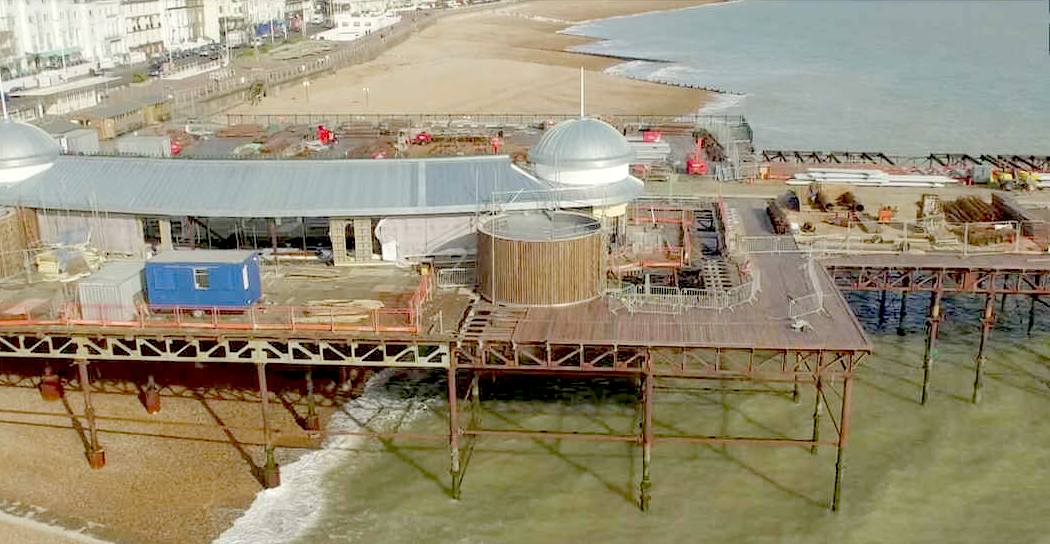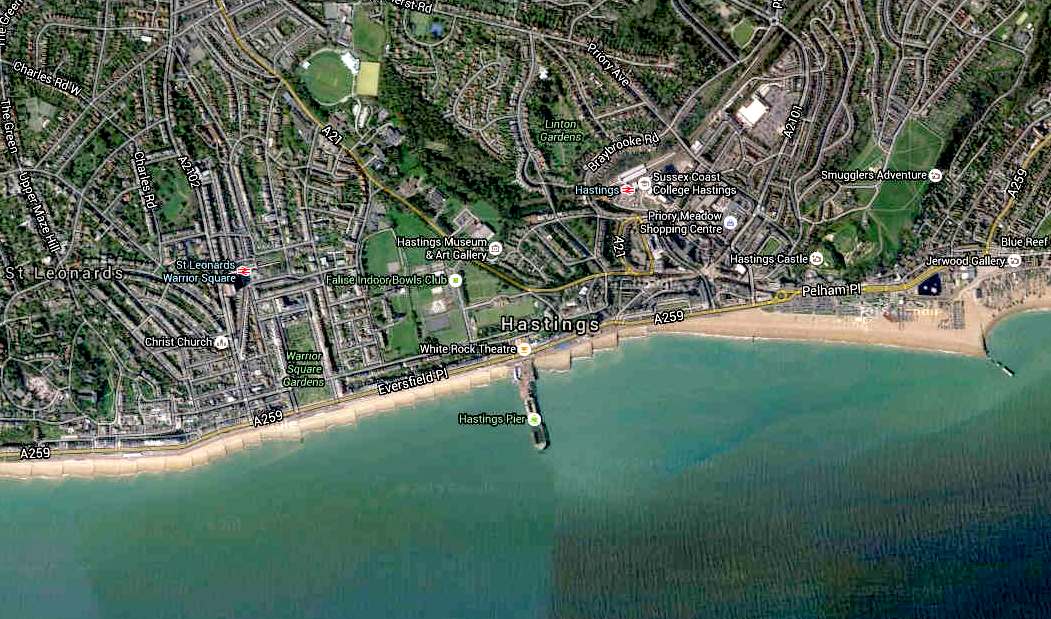|
HASTINGS
|
|
|
Hastings
is a town and local government district in South East England,
in the county of East Sussex. The population was about 84,000 in 2000.
Known as a seaside resort and for the Battle
of Hastings 1066,
which actually occurred at the nearby town of Battle. Hastings was one of
the Cinque Ports, but its significance as a port declined after the Middle
Ages and its main industry became fishing. It still has the largest
beach-based fishing fleet in England.
The town enjoyed some modest expansion in the latter part of the 20th
century.
Hastings town centre and Memorial from an old postcard
History
Hastings was not a Roman settlement, although there are traces of Iron Age or Romano-British earthworks. The town of Hæstingas (probably referring to the followers of an Anglo-Saxon leader called Hæsta), is mentioned in documents from the eighth century, and a royal mint was established there in the reign of Athelstan.
William the Conqueror made his headquarters here on his arrival in England, and the Battle of Hastings was fought a few miles a way near the present town of Battle. In this battle, William defeated and killed Harold Godwinson, the last Saxon King of England, and destroyed his army, opening England to the Norman conquest. After the conquest, William built a castle at Hastings, as depicted on the Bayeux Tapestry - probably the earthworks of the existing castle.
In the middle ages Hastings became one of the Cinque Ports; Sandwich, Dover, and New Romney being the first, Hastings, and Hythe followed, all finally being joined by Rye and Pevensey, at one point 42 towns were directly or indirectly affiliated to the group.
In the 13th century much of the town was washed away by the sea. In 1339 and 1377 the town was raided and burnt by the French, and seems then to have gone into a decline. As a port, Hastings suffered over the years from the lack of a natural harbour. There were many attempts to create a sheltered harbour, and in 1897 the foundation stone was laid of a large concrete structure; however there was insufficient money to complete the work, and the "Harbour arm" remains uncompleted. It was partially blown up to discourage possible use by German invasion forces during World War II. The fishing boats are still stored on and launched from the beach.
Hastings returned two Members of Parliament from the fourteenth century to 1885 since when it has returned one.
Like many coastal towns, the population of Hastings grew significantly as a result of the construction of railway links and the fashionable growth of seaside holidays during the Victorian era.
Hastings town centre 2005
Geography
Hastings is situated where the sandstone beds, at the heart of the Weald, known geologically as the Hastings Sands, meet the English Channel, forming tall cliffs to the east of the town. Hastings Old Town is in a sheltered valley between the East Hill and West Hill (on which the remains of the Castle stand). In Victorian times and later the town has spread westwards and northwards, and now forms a single urban centre with the more suburban area of St Leonards-on-Sea to the west. Roads from the Old Town valley lead towards the Victorian area of Clive Vale and the former village of Ore, from which "The Ridge", marking the effective boundary of Hastings, extends north-westwards towards Battle. Beyond St Leonards, the western end of Hastings is marked by low-lying land in the direction of Bexhill-on-Sea.
Hastings, East Sussex
The sandstone cliffs have been the subject of considerable erosion in relatively recent times: much of the Castle was lost to the sea before the present sea defences and promenade were built, and a number of cliff-top houses are in danger of disappearing around the nearby village of Fairlight.
The beach is mainly shingle, although wide areas of sand are uncovered at low tide. The town is generally built upon a series of low hills rising to 500 feet above sea level at "The Ridge" before falling back in the river valley further to the north. The town also has a large Victorian park, Alexandra Park.
Local government
Hastings was a borough by 1086, and gave its name to the Rape of Hastings, one of the six Rapes or administrative districts of Sussex.
As a borough, Hastings had a corporation consisting of a "bailiff, jurats, and commonalty". By a Charter of Elizabeth I in 1589 the bailiff was replaced by a mayor.
With the reform of English local government in 1888, Hastings became a County Borough, in other words responsible for all its local services, independent of the surrounding county, and long had its own police force. County borough status was abolished by the Local Government Act 1972 in 1974, and it became a district within the non-metropolitan county of East Sussex.
Fishing Net shops - Listed Buidlings
Buildings
The most important buildings from the late medieval period are the two churches in the Old Town, All Saints' and St Clement's. On the beach near the Old Town are the so-called "net shops", said to be unique to Hastings, but similar huts can be found in Whitby — these are wooden constructions, weatherboarded and tarred, of various shapes and sizes, used for storage. The buildings were built tall and narrow to avoid payment of ground tax. The huts were never used for net drying; this is a popular misconception: nets were dried on the beach or on the piece of land known as the Minnis.
Not much remains of Hastings Castle apart from an arch of the chapel, some walls, and underground dungeons.
In Medieval times the town featured a Priory, dedicated to the Holy Trinity. Remains of this were found when the old cinema was demolished and a supermarket built on the corner of Cambridge Gardens; these remains have been preserved and buried under the site. The area that was Priory Meadow Cricket Ground and latterly Priory Meadow Shopping Centre is the location of the Medieval Harbour, which was "lost" after several storms blocked the entrance. The area is still below sea level and prone to flooding.
Pelham Crescent and St Mary in the Castle, with the castle ruins above
In front of the castle is an elegant Georgian terrace, Pelham Crescent, at the centre of which is the classical church of St Mary in the Castle (its name recalling the old chapel in the castle above) now in use as an arts centre. The building of the crescent and the church necessitated further cutting away of the castle hill cliffs.
For many years the traffic intersection at the town centre was marked by "The Memorial", a clock tower commemorating Albert the Prince Consort, subsequently demolished, following an arson attack in the 1970s.
For many years the commercial centre of the town was divided by concrete barriers separating pedestrians from vehicles. The 1990s saw pedestrianisation of significant parts of the commercial heart of the town, restricting vehicle access to service vehicles only at all times.
The bathing pool at St Leonards-on-Sea was regarded in its day as one of the best open-air swimming and diving complexes in Europe, but it closed some years ago, having become part of a holiday camp. The area is still known by locals as "The Bathing Pool", which confuses some visitors as no pool exists.
The most notable recent architectural changes have been;
The pier at Hastings is not exactly the prettiest structure we've seen, but it is taking shape after all the hard work by the Trustees of this amazing local charity.
HASTINGS PIER
Hastings Pier is a closed pleasure pier in Hastings, East Sussex, England. Built in 1872 and enjoying its prime in the 1930s, though becoming a popular music venue in the 1960s, it received major storm damage in 1990, closed to the public between 1999 and 2002, partially closed in 2006, and closed completely in 2008. Efforts continued to save the pier, which was in need of much investment. In the early hours of 5 October 2010 the pier suffered from a devastating fire (the second in its history) that destroyed 95% of its superstructure. The Hastings Borough Council had structural surveys conducted in 2007 & 2010, which concluded that the cast iron Victorian-era sub-structure was salvageable, both before and after the fire. The White Rock Trust and Hastings Pier Charity are overseeing a reconstruction project, with the pier expected to reopen before the 2016 summer season.
The Hastings Pier & White Rock Trust was established to raise funds through various means to renovate the pier, ranging from community fund raising (cup collecting, raffles and quiz nights etc.) to larger scale grant applications. Their long-term goal is to acquire the pier and form a not-for-profit company to renovate, reopen and revitalise the pier as a community owned asset. The Hastings Pier and White Rock Trust (HPWRT) were strongly opposed to any decision to demolish and clear the site of the structure, which would cost an estimated £4 million of local money.
In August 2009, the Hastings Observer launched a campaign petition to Save the Pier, which is available for anyone interested in signing via an online website. More than 3,000 people have so far signed up. On Saturday 17 October 2009 more than 1,000 disgruntled residents marched along Hastings seafront to the Town Hall in protest of the Hastings Borough Councils' alleged lack of impetus with regard to dealing with the pier as an eyesore and its alleged unlawful sale to a foreign business, although there was no domestic interest. The march concluded with members of the Hastings Pier and White Rock Trust (HPWRT) handing a Compulsory Purchase Order pack, to the Council. It was hoped by many individuals and local small businesses that a decisive outcome would err in favour of promoting the seafront as a picturesque tourist attraction once again.
In November 2009 Kerry and Michelle Michael, along with a team of engineers, examined the possibility of purchasing Hastings Pier and restoring it to its former glory. These siblings also own The Grand Pier in Weston-super-Mare, which caught fire in 2008 and destroyed the pavilion, but they rebuilt it at a cost of more than £50million. However, after a structural assessment of the Hastings Pier, it was estimated that repairs would cost in excess of £24million, with a similar amount needed to restore attractions to the pier head. The engineers dismally commented that the pier is "one good storm away from collapse".
REDEVELOPMENT PLANS
CONTACT
HPC Hastings Pier Charity
Fishing
Until the development of tourism, fishing was Hastings' major industry. Steve Peak's monumental book on the fishing fleet, is a major work of scholarship and affection, available from the town's museums. The opening paragraph gives a flavour of the subject:
Hastings being no longer a port, fishing vessels have to be registered at Rye, and thus bear the letters R.X.
Hastings Pier and beach in the Winter
Visitor attractions
Hastings has a pier, built in the 19th century, and wholly updated in the early 21st century. At one time there was another pier at St Leonards. Opposite the pier is the White Rock Theatre which mainly stages traditional seaside light entertainment shows. North of this and a little way inland are a 25m public swimming pool and leisure centre at Summerfields. This also has the local museum, law courts, police and fire stations nearby.
Near the castle ruins, on the West Hill, are "St Clement's Caves", partly natural, but mainly excavated by hand from the soft sandstone.
There are a miniature railway, fairground rides and amusement arcades catering for tourists near the Fishmarket. The fishmarket includes the striking net shops, fisherman's museum and Hastings Sea Life Centre. Fishing boats are likely to be drawn up on the beach and there is a lifeboat station. Nearby is Hastings Old Town with a number of buildings dating from the earliest days of the town. There are two funicular railways, known as the East Hill Lift and West Hill Lift respectively. Slightly inland is the small Stables Theatre, which shows mainly local productions.
To the east of the town is the Hastings Country Park. This is an area of 2.67 km² of lightly wooded and open land extending from hastings approximately 3 miles (5 km) along the cliff tops to Fairlight.
Another family pool with wave machine and water slide is situated at Glyne Gap, on the coast mid-way between Bexhill and Hastings. Glyne Gap also sports a bowling alley and shopping centre.
There is a small cinema in Hastings but the nearest 'multiplex' is at Eastbourne. There is also a yearly carnival, an "Old Town Week" during August, a beer festival in Alexandra Park, and an International Chess Congress. During Hastings week held each year around the 14th October the Hastings Boroughs Bonfire Society stages a torchlight procession through the streets, beach bonfire and spectacular firework display.
The Saxon Shore Way starts at Gravesend, Kent and traces the coast as it was in Roman times as far as Hastings, 163 miles (262 km) in total.
Transport links
Hastings is linked to London by two railway lines. The shorter is the former South Eastern Railway (SER) route to Charing Cross via Battle and Tunbridge Wells, opened 1852, and the longer is the former London, Brighton and South Coast Railway (LBSCR) route to Victoria via Bexhill, Eastbourne and Lewes.
There is also the Marshlink Line via Rye to Ashford. The ex-SER route suffered for many years from the narrowness of some of its tunnels, so that special locomotives and rolling stock had to be built to meet the restricted loading gauge, for instance the Southern Railway's Schools Class and later the flat-sided Hastings diesels. This problem was eventually overcome, permitting the electrification of this line in 1996 and much improved services.
The town currently has four railway stations: from west to east they are West St Leonards, St Leonards Warrior Square, Hastings, and Ore. West Marina station (on the LBSCR line) was very near to West St Leonards (on the SER line) and was closed some years ago. New stations have been proposed.
Hastings is linked to London by the A21 trunk road. There have been improvements in this road over the years, notably bypasses for Sevenoaks, Tonbridge, Pembury and Lamberhurst, but the dual carriageway stops well short of Hastings. Long-term plans for a much improved east-west route and a Hastings bypass were abandoned in the 1990s, but a new road to Bexhill-on-Sea was announced in 2004 to relieve the congested coastal route (A259).
Hastings at one time had a network of trams, later replaced by trolleybuses. The "Save our trolleys" campaign was unsuccessful, and the town is now served by diesel buses.
View of houses from the East Hill Lift top entrance
Economic and social status
Hastings has long been known as a retreat for artists and painters. For example, the pre-Raphaelite painters including Dante Gabriel Rossetti and William Holman Hunt admired the town for its light and clear air. In the 19th century the towns became prosperous on the basis of the tourist trade from London and the Midlands. With the rise of international tourism from England it has declined substantially.
The town expanded as part of the Government policy to disperse population out of London in the 1960s and 70s. This brought with it some light industry. The policy was discontinued and further town growth is considerably restricted by planning policies of Rother District, which has administrative control of much of the undeveloped land adjoining Hastings. It is now one of the most economically disadvantaged districts in south-east England.
There is, at first glance, no immediate clear reason why Hastings should suffer from disadvantage when compared, for example, to its large neighbour to the west, Brighton. It has a very attractive setting, many very fine houses and a remarkably conserved Old Town, and contains within its Borough boundaries a major clifftop country park. It has a well documented depth of history. A key work is Historic Hastings by a former curator of Hastings Museum. Its principal drawback must be the considerably longer commuting times by rail to London and poor roads.
Hastings is currently the site of major regeneration. Already a new rail station has been built and the University Centre Hastings (UCH) has been created to provide higher education in the town for the first time. (Hastings College of Arts and Technology and University Centre Hastings) Further major capital investment is committed and a range of vocational training, community development and neighbourhood regeneration projects are in place. This is hampered by the split administration of the combined Hastings and Bexhill economic region between Hastings and Rother councils.
LINKS & REFERENCE
http://www.hpcharity.co.uk/ https://en.wikipedia.org/wiki/Hastings_Pier
East Hill Lift: one of the two funicular railways in Hastings
SUSSEX INDEX A - Z
CHIDDINGLY - HORSE SHOW and GYMKHANA CUCKMERE VALLEY - EXCEAT HERSTMONCEUX - MUSEUM - COSTS SCANDAL - PARISH COUNCIL - 70 HOUSES TWISSELLS MILL, OLD HEATHFIELD
Hastings is famous for its beach launched fishing boats
A taste for adventure capitalists
Solar Cola - a healthier alternative
|
|
|
This
website
is Copyright © 1999 & 2015. The bird |













